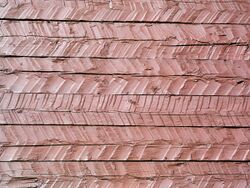Engineering:Hewing

In woodworking, hewing is the process of converting a log from its rounded natural form into lumber (timber) with more or less flat surfaces using primarily an axe. It is an ancient method, and before the advent of the industrial-era type of sawmills, it was a standard way of squaring up wooden beams for timber framing. Today it is still used occasionally for that purpose by anyone who has logs, needs beams, and cannot or would prefer not to pay for finished lumber. Thus, homesteaders on frugal budgets, for example, may hew their own lumber rather than buy it.
Definitions
Hew is a general term meaning to strike or blow with a tool such as an axe or sword; to chop or gash, and is used in warfare, stone and woodcutting, and coal and salt mining in this sense.[1][2] Hewing wood is to shape the wood with a sharp instrument such as an axe,[3] specifically flattening one or more sides of a log.
Methods
As an ancient method of timber conversion, different methods of each step in hewing have developed in history.
Prepare log
After a tree is selected and felled, hewing can take place where the log landed or be skidded or twitched (skidded with a horse or oxen) out of the woods to a work site. The log is placed across two other smaller logs near the ground or up on trestles about waist height; stabilized either by notching the support logs, or using a 'timber dog' (also called a log dog,[4] a long bar of iron with a tooth on either end that jams into the logs and prevents movement). The hewer measures and locates the timber within the log on both ends and marks lines along the length of a log, usually with a chalk line.
Scoring
The next step is to chop notches every foot or two, almost as deep as the marked line using a chopping or scoring axe, called scoring. At least three methods are used in scoring. 1) Standing on the log and swinging an axe to chop the score; 2) In Germany a method of two carpenters standing on the ground with the log on trestles and swinging downward to slice the scores. (see video in link below); 3) A chainsaw is used to notch the log, the sections created by the notching are then split off using a felling axe.
Joggling or juggling
The pieces of wood between the notches are knocked off with an axe, this process called juggling[5][6] or joggling.[7] This results in a rough surface pared down just shy of the marked line. Scoring and juggling remove a fair amount of wood, make hewing easier and prevent long shreds of wood being torn off.
Hewing
Hewing is the last step in this whole process, which is also collectively referred to as hewing. Hewing is done on the logs sides with a broadaxe. Hewing occurs from the bottom of the stem upwards towards what was the top of the standing tree, reducing the tendency of the broken fibers to migrate inwards towards the eventual beam.[8]
It is widely published that an adze was used to hew the top surface of a log flat in the same manner as an axe is used on the sides of a log. However, physical evidence of looking at the marks left by the hewing tools in historic buildings, called tracology, are swung in an arc and thus made by an axe, not an adze.[citation needed] Shipbuilders frequently used adzes in shaping ship timbers, the choice of tool being made by the position of the surface being hewn, the sides best hewn with an axe and the face best hewn with an adze. Historic illustrations do show some Asian carpenters hewing building timbers with an adze. Further smoothing can then be done using a hand plane, drawknife, yariganna (an ancient Japanese cutting tool) or any other established or improvised means.
Some 19th-century timber buildings in the U.S. have hewn long timbers in the same framing with vertically sawn and the later technology of circular sawn timbers. The reason for this is the long timbers were easier to hew with an axe than to take to a sawmill due to poor transportation routes.
Hewn railroad ties are known as axe ties and were made by a tiehacker.[9]
Modern uses
Although still used in niche modern building, salvaged hand-hewn beams are now commonly recycled as architectural details popular in new construction and renovation of homes. They are also popular as decor in commercial and restaurant spaces.[10]
References
- ↑ "Hew v." def. 2. Oxford English Dictionary, 2nd ed. 2009.
- ↑ Wright, Joseph. "Hew" The English dialect dictionary, being the complete vocabulary of all dialect words still in use, or known to have been in use during the last two hundred years;. London etc.: H. Frowde;, 18981905. Print.
- ↑ "Hew | Definition of hew by Merriam-Webster". Merriam-webster.com. http://www.merriam-webster.com/dictionary/hewing.
- ↑ Kauffman, Henry J.. American axes: a survey of their development and their makers. Morgantown, PA: Masthof Press, 2007.
- ↑ McRaven, Charles. The classic hewn-log house: a step-by-step guide to building and restoration. North Adams, MA: Storey Pub., 2005.
- ↑ (in en) Dialect Notes. American Dialect Society. 1900. https://books.google.com/books?id=iEMOAAAAYAAJ.
- ↑ McGrail, Seán. Woodworking techniques before A.D. 1500: papers presented to a symposium at Greenwich in September, 1980, together with edited discussion. B.A.R. 1982. 389. books.google.com/books?id=RJnfAAAAMAAJ
- ↑ "An Ax to Grind: A Practical Ax Manual, 9923-2823-MTDC, About the Author". Fhwa.dot.gov. http://www.fhwa.dot.gov/environment/fspubs/99232823/page23.htm.
- ↑ Marples, Geoff. "The Tiehack", part 1.. British Columbia Forest History Newsletter. No. 60. August 2000. Victoria, B. C., Forest History Association of British Columbia. p. 1-4. print.
- ↑ "About Hand-Hewn Beams". Longleaf Lumber Inc.. 15 January 2014. http://www.longleaflumber.com/about-hand-hewn-beams/.
LINK FOR 8 SHOULD BE https://www.fs.fed.us/t-d/pubs/pdfpubs/pdf99232823/pdf99232823Pdpi300.pdf
External links
- Video of the German method of hewing
- Video of a widespread method of scoring a log in the process of hewing
 |



